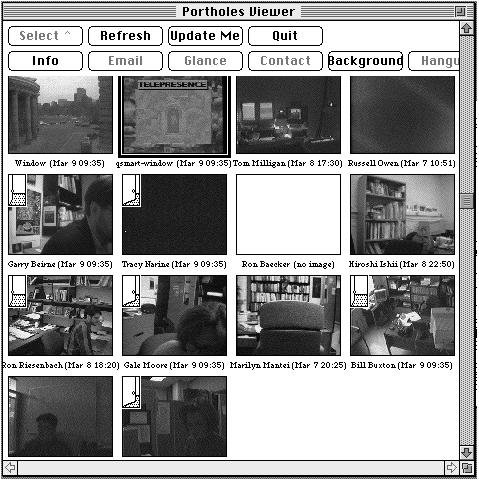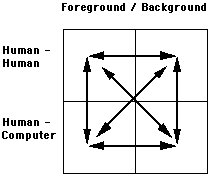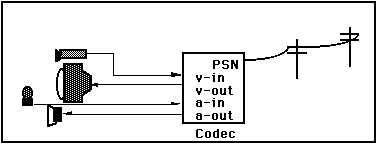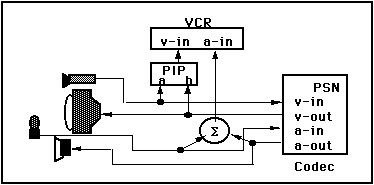
Figure 1: The Basic Model
Buxton, W. (1995). Integrating the Periphery and Context: A New Model of Telematics Proceedings of Graphics Interface '95, 239-246.
Integrating the Periphery and Context: A New Taxonomy of Telematics
Bill BuxtonUniversity of Toronto & Alias Research Inc.
c/o CSRI
University of Toronto
Toronto, Ontario
Canada M5S 1A4
buxton@dgp.toronto.eduABSTRACT
From technical journals to the popular press, we are being told about the brave new world of "the electronic super highway," computer-supported collaborative work, "infotainment" and other such services emerging out of the convergence of telecommunications, consumer electronics and information technologies. But as with "multimedia," the details are about as clear as the early morning fog. Models of use tend to be appliance-centric, focussing either on the television (home shopping and video-on-demand) or personal computer (Internet). Few if any can tell a coherent and unifying story even at this course level of analysis.Clearly, changes are coming, and to reap the potential benefits, the level of discourse must be raised significantly. The prime objective of this presentation is to contribute to laying the foundation for such a discourse. We introduce a new human-centric model with which future technologies can be characterized. The model presents a unified framework for looking at human-computer as well as technology mediated human-human interaction. A prime property of the model is the consideration it gives to both foreground and background interactions.
Keywords: videoconferencing, CSCW, telecommunications, electronic highway, technology convergence
There are two main concerns that arise from this situation. The first is the limited scope of the applications that are being investigated. The second is our belief that the real value lies in the symbiotic relationships among a suite of applications, rather than the value of any one "killer" application. Hence, approaches that are limited to individual applications, or applications in isolation, run the risk of missing the target. If true, then the consequence is that a far more holistic approach must be taken.
In what follows, we introduce a new model which is directed at supporting just such a holistic way of thinking about such systems. Our hope is that it is simple enough to be understood and used, yet rich enough to be useful.
Our belief is that these emerging technologies have real potential
for social benefit. If this model makes some contribution to the realization
of this potential, then it will have served its purpose.

Figure 1: The Basic Model
The two dimensions are the ground, as represented by the columns, and object of communication, as represented by the rows. The dimension of "ground" is the one most needing clarification. By this we do not mean synchronous/asynchronous. That is covered in the previous complimentary taxonomy. What we mean by Foreground are activities which are in the fore of human consciousness - intentional activities. Speaking on the telephone, or typing into a computer are just two examples.
By Background, we mean tasks that take place in the periphery - "behind" those in the foreground. Examples would include being aware of someone in the next office typing, or the light in your kitchen going on automatically when you enter it, as opposed to you manually flicking the switch (which would be a foreground intentional act).
The two rows concern who or what the user is communicating with: another human, or a computer. Human-Human communication in the foreground might be a simple telephone call. (In this row, we actually mean technology mediated human-human interaction.) The second row, Human-Computer communication, can characterized by interactions with a computer using a graphical user interface (GUI).
From this simple model, we can already derive some valuable observations. First, while it is easy to populate the left column, this is much less true with the right one. Second, nearly all work in technology mediated human-human and human-computer interaction falls within the left column. However, a fundamental belief of our work is that the real "sweet spots" of future applications lie on the right hand side. This requires further explanation.
Based on this observation, what we propose is required is a means of sharing the periphery, the background social ecology, by means of appropriate technological prostheses. Used in combination with the existing (and new) methods for supporting foreground conversation, we believe we will achieve a significant improvement in the sense of copresence, or "telepresence."
One example of such a technology is referred to in the upper right corner of Figure 1, the Portholes system developed by Xerox PARC and Rank Xerox EuroPARC (Dourish & Bly, 1992). Portholes is a system which takes video "snapshots" of members of a community every 5 minutes, and circulates them to the computer screens of the members of that same community, as shown in Figure 2. Hence, all members have an increased awareness of who is in, what they are doing and if they might be available. They also provide a means of combating the all too human tendency towards "out of sight, out of mind." All members of the community have a visual presence, regardless of actual geographical location.
Our claim is that Portholes is an excellent example of a background
"awareness server," of which there are many others.

Figure 2: Portholes
Likewise, along the Human-Computer interaction dimension, there are also background technologies. The example cited in the bottom right quadrant of the figure is "smart house" technology. These are technologies that turn down the heat on weekends, automatically water your plants, close blinds, turn on lights, etc., under computer control.
The real power of this model comes not from merely populating the individual quadrants, but by providing the means to make transitions seamlessly from quadrant to quadrant. This is illustrated by the arrows in the version of the model shown in Figure 3.
Let us illustrate this point with an example that will relate to a problem familiar to many: trying to arrange a conference call among a number of colleagues, all of whom are busy, hard to reach, and at different sites.

Figure 3: Seamless Transitions Between Quadrants
Using our tools, the user would glance at their portholes window to determine if the people seemed to be available. If so, they would use portholes itself to contact them and the problem is solved - we would have made a transition from the top right to the top left quadrant (via the bottom left, when interacting with portholes).
However, what if the more typical case were true: nobody appeared to be available. In this case we instruct an process on our machine to let us know when the parties are available. This is done by simply selecting the appropriate people by pointing at their portholes images, and selecting an operator, such as "set up videoconference when available." Moving to the bottom right quadrant, in the background - while you resume other work - the process "looks" at the incoming portholes images, looking for any changes. Through simple image processing it can detect comings and goings in the remote offices. When all parties appear to be available, the process initiates a foreground dialogue with the user, suggesting that now might be an opportune time for the meeting. If so, the user initiates the meeting, and the conversation begins. In a seamless manner, one has moved counter-clockwise from the top right to the top left quadrant. High value and functionality is obtained with minimal complexity for the user. A prosthesis which makes up for many of the problems of distance is provided.
Our belief is that this is just one example of many, and that the architecture
which we are pursuing affords exploring such synergies in an effective
and coherent manner.

Figure 4: Bandwidth and Persistence
What we have added here are labels that characterize the bandwidth of the two columns. It is our claim that generally speaking, activities in the left column are high bandwidth, but bursty, whereas those in the right are relatively low bandwidth, but persistent. For example, a videophone call is high bandwidth, but we may only make 5 calls a day. On the other hand, distributing Portholes images is persistent, going on constantly in the background. However, the bandwidth required to distribute images is relatively low. Viewed in the context of seamlessly moving from quadrant to quadrant, what we have is a means of capturing the notion of "bandwidth on demand." Furthermore, the model which emerges from this approach is in may ways richer that those commonly used, such as video on demand.
Finally, note that there are some subtle but important economic and technical issues that emerge from this seemingly simple example. Note that a large percentage of telephone volume traffic consists of incomplete calls. This consumes switch capacity and bandwidth, yet there is no cost-recovery mechanism (i.e., we don't get charged for incomplete calls, such as when nobody is home, or the line is busy). But notice two things from the example. First, mechanisms like Portholes and other background processes have the potential to greatly reduce such non-billable traffic. Second, these very same processes are of value to the consumer. Hence, they not only have the potential to reduce non-billable consumption of resources, they are of sufficient value that the user will be willing to pay for them.
Walking into a room and having the lights automatically go on
is a simple example of how complexity can be reduced by background sensing
of the environment of action. While the person is responsible for the foreground
action (walking into a room), the responsibility (load) associated with
the background action (turning the lights on) is assumed by the system
and the associated motion sensor driven switch. There is an irony here.
What is the mechanism here? A "smart" switch. But what are computers made
up of? Millions of switches. So if computers are so smart and artificial
intelligence is such a big thing, why is it that none of the switches in
my computer are as "smart" as the switch in the coffee room two doors down
from my office? I realize the rhetorical nature of the question; however,
my light example serves the purpose of illuminating my central belief that
we can reduce the complexity while improving the functionality of future
systems if they incorporate similar background sensing to support foreground
action.

Figure 5: Context-Sensitive Interaction
Photography offers another example - one which leads us to a practical application of this approach to design. As a start, consider my first camera. It had two controls: the button to snap a picture and the handle for advancing the film. While rather inflexible, it was easy to use. It was "point and shoot," and then roll the film. My next camera was a marvel of technology. I could adjust it in any number of ways and get virtually any effect that I could imagine. The only problem was, without a Ph.D. in "Camera Arts", the likelihood of getting anything usable, much less what I wanted, was low. My current camera, however, has the best of both worlds. It has all of the controls that an expert could dream of. But for mere mortals, good - even excellent - results can be obtained by the simple old "point-and-shoot" approach. And you don't even have to remember to roll the film yourself.
All of this is achieved because, in the background, the camera senses all kinds of things: what the subject is, its distance from the camera and the illumination of the subject and the surround. All of this is integrated with knowledge about the kind of film so that the camera can automatically set its configuration to a state appropriate for the foreground action of the photographer. Like the light example, the only cognitive burden on the user is that imposed by the foreground action. Context-sensitive system state is maintained automatically the background.
Now consider the increasingly common task of scanning documents into computers. Does this not have a strong resemblance to my experience with my second camera? The task normally involves setting a relatively large number of controls, and several attempts are generally required before achieving acceptable results. This is especially true when dealing with complex documents, such as those consisting of a colour photograph, text and artwork all on the same page.
Here is a prime candidate for applying precisely the same kind of automation that we see in modern cameras. Like the camera, a "smart" scanner is able to sense relevant properties of its "subject" and adapt its processing accordingly. In this case, however, it is going to base its decisions on a knowledge of document morphology and properties of the page being scanned. But the process is essentially the same. The user just places the document in the scanner ("points") and pushes as single button ("shoots"). All of the parameters that determine the state of the scanner are set automatically, thereby reducing the cognitive burden of system operation to that of the simplest copier.
And what does the user get for this single button push? The contrast is set automatically and adaptively on different parts of the page, the colour photo on the hypothetical page is scanned at 24 bits/pixel, the gray-scale image at 8 bits/pixel, and the line art and text at 1 bit/pixel. This alone results in higher quality, less complexity and significant reduction in file size. (Remember, the norm in this example would be to scan the whole page at the "worst case" condition: 24 bits/pixel overall.) But we get even more. Having isolated the different morphological parts of the page, we can compress each with the algorithm most suited to the type. Hence, quality and storage are even further optimized automatically.
As our last example, let us push to a scenario a bit further from mainstream computation. You are in a videoconference with a colleague. You each have the requisite camera, monitor, microphone and speaker, all of which are connected to your coder/decoder (CODEC). This is illustrated in Figure 6.[1]
Now consider what would be required if in the midst of your conversation, it was suggested that you record a part of the meeting. Assuming that you have a VCR, this should be fairly simple, shouldn't it? After all, you know how to put a tape into a VCR and hit record. But it is not. The wiring plan is shown in Figure 7. This makes working a manual camera seem simple by comparison!
In order to record the conference, both the incoming and outgoing video signals need to be combined using a "picture-in-picture" (PIP device) before being fed into the VCR. Likewise, both the incoming and outgoing audio signals must be mixed together before recording. Assuming all of this was cabled together correctly and the conference recorded successfully. Now consider what would happen if your remote colleague asked to see the recorded segment. This would require a complete reconfiguration of the A/V gear, in a manner such as shown in Figure 8.
This configuration lets both sides hear and see the video, as well as talk to each other over the soundtrack, while it is playing. It also lets me, the presenter, see you in a small window on the screen while you watch the tape.
The first observation is that working at the cable level, a fair amount of knowledge is required to set up any of these configurations. While more common than it should, users should never have to work at this level. Consequently, current design practice would be to have some kind of preset button for each configuration. In this case, recording or playing back a tape would be a two step operation: selecting the appropriatepreset, then operating the VCR. A variation would be to have the preset also control the VCR, thereby reducing the transaction to one step.

Figure 6: A Simple Videoconferencing Configuration

Figure 7: Recording a Video Conference

Figure 8: Playing back a tape in a videoconference
The third approach is the one which most follows from our context sensitive approach. In this case, the user just puts the tape in the VCR and hits the "record" or "playback" buttons. The state of the VCR is monitored by the computer, as is the state of the room (i.e., the fact that the user is in a videoconference). Consequently, the computer automatically reconfigures the A/V network in the background, based on the system state, or context, in which the user's foreground action takes place.
There are some subtle but important distinctions between this third solution and the more conventional second approach. This is not a computer-controlled VCR. Rather, it is a VCR controlled computer. Users interacts directly with the components in the workplace with which they are familiar. In this case, it is a VCR. The interface is decentralized and builds upon existing skills. By decentralizing, we move away from the "super appliance" approach which is prevalent today, in which all of our interactions with the electronic domain are channeled through one of two overworked and less than appropriate appliances: the television and the computer. This centralized approach will not scale up as the range of applications expands.
Systems that do make use of context and knowledge of the domain to reduce the load on the user are now practical and are beginning to appear commercially. Easy Scan, a new system from Xerox Corp. has precisely the properties described in the scanning example, above. Our belief is that this class of architecture will play an increasing role in future systems design. Our hope is that our arguments and examples will accelerate the process whereby this comes to pass.
What is equally important is the point that this model has emerged from a methodology based on placing the emphasis on usage not technology. As such, it provides some motivation to redistribute resources in such a way as to put more emphasis in this area in the future.
Elrod, S., Hall, G., Costanza, R., Dixon, M. & Des Rivieres, J. (1993) Responsive office environments. Communications of the ACM, 36(7), 84-85.